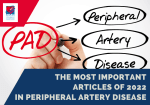Studies and registries assessing sex differences in chronic total occlusions (CTO) are limited and women are under-represented, accounting for only 14%-21% of included patients. Even though success rate is comparable between sexes, several studies have shown higher complications rate among women. The aim of this study was to identify sex related baseline and procedural differences,...
Left Main Coronary Artery Revascularization: Are Periprocedural Complications Significant?
In the field of percutaneous coronary intervention (PCI) and myocardial revascularization surgery (MRS), previous analyses have shown a link between in-hospital and 30-day complications, in terms of complicated progress and/or mortality. Most of this information comes from non-randomized or old studies, which translates into contradictory data. Researchers analyzed the EXCEL study, which included patients with...
ACC 2023 | Complete Revascularization Strategies in patients with ACS and Multivessel Disease
In patients with acute coronary syndrome (ACS) and multivessel disease, complete revascularization is associated with better clinical outcomes. However, for non-culprit vessel revascularization the strategy remains unclear. The aim of this multicenter, open label, randomized, non-inferiority study, was to determine whether complete revascularization during index procedure is non inferior vs. staged. Primary end point was...
Microvascular Dysfunction in Symptomatic Patients with Intermediate Coronary Lesions Prognostic impact according to different patterns
Coronary microvascular dysfunction (CMD) is emerging as an important cause of myocardial ischemia, and its role in the pathogenesis of cardiovascular disease—including angina patients with nonobstructive coronary lesions—is well known. Currently, there are several definitions of CMD and several invasive and noninvasive diagnostic tests. Using invasive tests, heterogeneous patterns of microvascular dysfunction, such as coronary...
Rivaroxaban in Acute Coronary Syndrome
Acute coronary syndromes (ACS) involve high mortality risk, especially ST elevation ACS. Their treatment is based on reperfusion, dual antiplatelet therapy (DAPT) and anticoagulation, with enoxaparin (1 mg/kg twice a day) as the preferred anticoagulant according to the contemporary guidelines. 2.5 mg or 5 mg doses of rivaroxaban might be valid alternative treatments for this...
Should We Use Drug Coated Balloons in Patients with Multivessel Disease?
Recent studies have shown that a drug coated balloons (DCB) based approach resulted non inferior when compared against drug eluting stents (DES) only approach in patients with instent restenosis and de novo lesions in small vessel disease. So far, two international consensuses have reported the use of DCB is feasible and safe to treat native...
Is Using Drug-Eluting Balloons and Single Antiplatlelet Therapy Safe for Patients at High Risk for Bleeding Who Undergo Percutaneous Coronary Intervention?
The safety and efficacy of drug-coated balloons (DCB) has been established for the treatment of in-stent restenosis of conventional bare-metal stents (BMS) and drug-eluting stents (DES). Furthermore, these devices are also used to treat de novo coronary lesions, as demonstrated in the BASKET-SMALL 2—where DCBs were non-inferior to stents—and the DEBUT RCT trials—, where DCBs...
Long-Term Evolution of Hybrid Coronary Revascularization
Currently, myocardial revascularization surgery (MRS) and percutaneous coronary intervention (PCI) are the available strategies for multivessel coronary artery disease. However, an alternative strategy has long been developed, called hybrid coronary revascularization (HCR), where the anterior descending artery is bypassed with a graft from the mammary artery and the rest of the lesions are treated by...
Non-ST Elevation MI: How Long Do We Have for A Coronary Angiography?
This summary discusses the early invasive strategy and the risk of mortality in non-ST-elevation AMI. Over the past 2 decades, mortality and complications rates have seen a significant reduction thanks to technological and pharmaceutical development, and the increasing experience of health teams. This is especially true when we look at the use of coronary angiography...
The Most Important Articles of 2022 in Peripheral Vascular Disease
Discover the most important scientific articles of 2022 in peripheral vascular disease in our website. EMINENT Trial | Stent Eluvia vs BMS in Femoropopliteal Territory Endovascular therapy in femoropopliteal territory has become the standard, mainly with self-expanding stents, aimed at preventing early vascular recoil and late constrictive remodeling. Thromboendarterectomy vs. Endovascular Therapy in Common Femoropopliteal...









